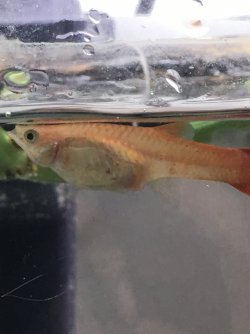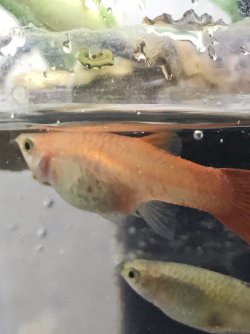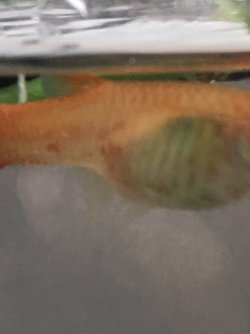My female guppy has always been on the bigger side so I’m not sure if she’s pregnant right now or not. I got her 2 weeks ago and she’s been fine but today after a water change I noticed she has some red spots on her. There might also be some white fuzz near the spots? But it’s very subtle so I might just be imagining it. She’s been lethargic and just floating around. She hasn’t eaten today from what I can tell. I don’t know if that’s because she might be pregnant or because of the whatever is causing the spots. Any advice?? There is 1 male and 2 females in the tank at the moment. And 2 mollies. Photos of the female in question are attached.
You are using an out of date browser. It may not display this or other websites correctly.
You should upgrade or use an alternative browser.
You should upgrade or use an alternative browser.
The April FOTM Contest Poll is open!

🏆 Click to vote! 🏆
She's more than likely pregnant as they pretty much spend their lives like that if they go near a male!
Ideally you would be better to have an extra female in there so that the male has someone else to bother and doesn't just focus on the two females.
Its difficult to tell from the photos but its possible that there are one or two missing scales on the fish and the other marks are just the patterning. The behaviour of the fish is more concerning though.
What size tank is this? Is it just the guppies and mollies in it or are there any other fish? Have you checked the water perameters? How long has it been set up?
Ideally you would be better to have an extra female in there so that the male has someone else to bother and doesn't just focus on the two females.
Its difficult to tell from the photos but its possible that there are one or two missing scales on the fish and the other marks are just the patterning. The behaviour of the fish is more concerning though.
What size tank is this? Is it just the guppies and mollies in it or are there any other fish? Have you checked the water perameters? How long has it been set up?
Is the fish breathing heavily? She looks like she has flared gills in the picture and that could indicate gill flukes are causing some issues to her.
She also appears to have a few unusual marks on her body and they could be from another fish biting her, however that is unlikely considering there are only mollies and guppies in the tank. It is more likely a protozoan infection.
Gill flukes and most protozoan infections can be easily treated in live bearers by adding salt (sodium chloride). Add 2 heaped tablespoons of aquarium salt, rock salt, swimming pool salt or sea salt per 20 litres of tank water. If there is no improvement after a few days you can double that dose. Keep the salt level high for at least 2 weeks then do small 10% water changes each day for a week to dilute the salt. Then do normal water changes after that.
Before you add the salt, do a 75% water change and complete gravel clean, wipe the inside of the glass down, and if you haven't cleaned the filter in the last month then do that too. Wash filter materials in a bucket of tank water.
Make sure any new water is free of chlorine/ chloramine before it is added to the tank.
To work out the volume of water in your tank:
measure length x width x height in cm.
divide by 1000.
= volume in litres.
When you measure the height, measure from top of the substrate to top of the water level.
There is a calculator/ converter in the "How To Tips" at the top of this page that will let you convert litres to gallons.
She also appears to have a few unusual marks on her body and they could be from another fish biting her, however that is unlikely considering there are only mollies and guppies in the tank. It is more likely a protozoan infection.
Gill flukes and most protozoan infections can be easily treated in live bearers by adding salt (sodium chloride). Add 2 heaped tablespoons of aquarium salt, rock salt, swimming pool salt or sea salt per 20 litres of tank water. If there is no improvement after a few days you can double that dose. Keep the salt level high for at least 2 weeks then do small 10% water changes each day for a week to dilute the salt. Then do normal water changes after that.
Before you add the salt, do a 75% water change and complete gravel clean, wipe the inside of the glass down, and if you haven't cleaned the filter in the last month then do that too. Wash filter materials in a bucket of tank water.
Make sure any new water is free of chlorine/ chloramine before it is added to the tank.
To work out the volume of water in your tank:
measure length x width x height in cm.
divide by 1000.
= volume in litres.
When you measure the height, measure from top of the substrate to top of the water level.
There is a calculator/ converter in the "How To Tips" at the top of this page that will let you convert litres to gallons.
Is the fish breathing heavily? She looks like she has flared gills in the picture and that could indicate gill flukes are causing some issues to her.
She also appears to have a few unusual marks on her body and they could be from another fish biting her, however that is unlikely considering there are only mollies and guppies in the tank. It is more likely a protozoan infection.
Gill flukes and most protozoan infections can be easily treated in live bearers by adding salt (sodium chloride). Add 2 heaped tablespoons of aquarium salt, rock salt, swimming pool salt or sea salt per 20 litres of tank water. If there is no improvement after a few days you can double that dose. Keep the salt level high for at least 2 weeks then do small 10% water changes each day for a week to dilute the salt. Then do normal water changes after that.
Before you add the salt, do a 75% water change and complete gravel clean, wipe the inside of the glass down, and if you haven't cleaned the filter in the last month then do that too. Wash filter materials in a bucket of tank water.
Make sure any new water is free of chlorine/ chloramine before it is added to the tank.
To work out the volume of water in your tank:
measure length x width x height in cm.
divide by 1000.
= volume in litres.
When you measure the height, measure from top of the substrate to top of the water level.
There is a calculator/ converter in the "How To Tips" at the top of this page that will let you convert litres to gallons.
I put her into isolation yesterday before bed because I was concerned and she started to float sideways and upside down but when I tapped on the glass would make an attempt to straighten up and swim. This morning I found her dead and somewhat bloated from the looks of it. Should I salt the main tank just to be safe that whatever it is didn’t spread to the rest of them?
You can add salt if you like. It will kill most of the nasties in the water, however, if it is an internal bacterial infection the salt won't make any difference. But for gill flukes and protozoans, it will help. Just do a big water change and gravel clean first, then add salt and leave it in the tank for 2 weeks before diluting it out.
Latest Discussions
- Replies
- 1
- Views
- 23
- Replies
- 5
- Views
- 51
- Replies
- 2
- Views
- 59
- Replies
- 1
- Views
- 45
- Replies
- 1
- Views
- 65
trending
-
-
-
-
-
F-1 Angel... a bit nervous... it'll be my 1st F-1 fish...
- Started by Magnum Man
- Replies: 17
Staff online
-
EssjayModerator
Members online
Total: 431 (members: 5, guests: 426)




